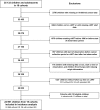Kaposi Sarcoma Risk in HIV-Infected Children and Adolescents on Combination Antiretroviral Therapy From Sub-Saharan Africa, Europe, and Asia
- PMID: 27578823
- PMCID: PMC5064163
- DOI: 10.1093/cid/ciw519
Kaposi Sarcoma Risk in HIV-Infected Children and Adolescents on Combination Antiretroviral Therapy From Sub-Saharan Africa, Europe, and Asia
Abstract
Background: The burden of Kaposi sarcoma (KS) in human immunodeficiency virus (HIV)-infected children and adolescents on combination antiretroviral therapy (cART) has not been compared globally.
Methods: We analyzed cohort data from the International Epidemiologic Databases to Evaluate AIDS and the Collaboration of Observational HIV Epidemiological Research in Europe. We included HIV-infected children aged <16 years at cART initiation from 1996 onward. We used Cox models to calculate hazard ratios (HRs), adjusted for region and origin, sex, cART start year, age, and HIV/AIDS stage at cART initiation.
Results: We included 24 991 children from eastern Africa, southern Africa, Europe and Asia; 26 developed KS after starting cART. Incidence rates per 100 000 person-years (PYs) were 86 in eastern Africa (95% confidence interval [CI], 55-133), 11 in southern Africa (95% CI, 4-35), and 81 (95% CI, 26-252) in children of sub-Saharan African (SSA) origin in Europe. The KS incidence rates were 0/100 000 PYs in children of non-SSA origin in Europe (95% CI, 0-50) and in Asia (95% CI, 0-27). KS risk was lower in girls than in boys (adjusted HR [aHR], 0.3; 95% CI, .1-.9) and increased with age (10-15 vs 0-4 years; aHR, 3.4; 95% CI, 1.2-10.1) and advanced HIV/AIDS stage (CDC stage C vs A/B; aHR, 2.4; 95% CI, .8-7.3) at cART initiation.
Conclusions: HIV-infected children from SSA but not those from other regions, have a high risk of developing KS after cART initiation. Early cART initiation in these children might reduce KS risk.
Keywords: HIV; Kaposi sarcoma; antiretroviral therapy; children; cohort study.
© The Author 2016. Published by Oxford University Press for the Infectious Diseases Society of America. All rights reserved. For permissions, e-mail journals.permissions@oup.com.
Figures


Comment in
-
Reply to El-Mallawany et al.Clin Infect Dis. 2017 Mar 15;64(6):819-820. doi: 10.1093/cid/ciw880. Clin Infect Dis. 2017. PMID: 28077521 Free PMC article. No abstract available.
-
Increasing Numbers of New Kaposi Sarcoma Diagnoses in HIV-Infected Children and Adolescents Despite the Wide Availability of Antiretroviral Therapy in Malawi.Clin Infect Dis. 2017 Mar 15;64(6):818-819. doi: 10.1093/cid/ciw879. Clin Infect Dis. 2017. PMID: 28077522 Free PMC article. No abstract available.
References
-
- Biggar RJ, Frisch M, Goedert JJ. Risk of cancer in children with AIDS. AIDS-Cancer Match Registry Study Group. JAMA 2000; 284:205–9. - PubMed
-
- Chiappini E, Galli L, Tovo PA et al. Cancer rates after year 2000 significantly decrease in children with perinatal HIV infection: a study by the Italian Register for HIV Infection in Children. J Clin Oncol 2007; 25:97–101. - PubMed
Publication types
MeSH terms
Substances
Grants and funding
LinkOut - more resources
Full Text Sources
Other Literature Sources
Medical
Research Materials

